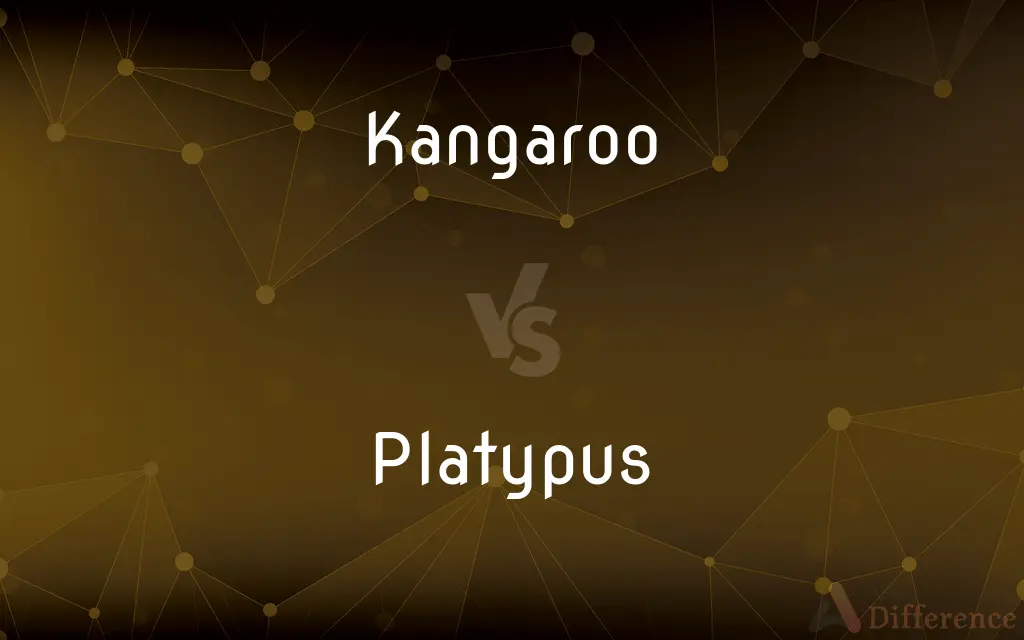Kangaroo vs. Platypus — What's the Difference?
By Fiza Rafique & Maham Liaqat — Updated on April 30, 2024
Kangaroos are large marsupials known for their strong hind legs and hopping movement, while platypuses are small, aquatic monotremes recognized for their duck-billed appearance.

Difference Between Kangaroo and Platypus
Table of Contents
ADVERTISEMENT
Key Differences
Kangaroos are most notable for their unique method of locomotion; they move primarily by hopping using their powerful hind legs. In contrast, platypuses are adapted to an aquatic lifestyle, using their webbed feet to swim efficiently.
Kangaroos are found exclusively in Australia, thriving in a variety of environments from grasslands to forests. Platypuses, also native to Australia, prefer freshwater rivers and lakes, which provide the necessary conditions for their hunting and breeding.
While kangaroos give birth to extremely underdeveloped young, which continue to develop in the mother's pouch, platypuses lay eggs, one of the few mammals to do so. The young platypuses hatch from these eggs and are then fed with milk from the mother's mammary glands.
Kangaroos are primarily herbivores, grazing on grasses and shrubs, which reflects their adaptation to expansive, open landscapes. On the other hand, platypuses are carnivorous, feeding on aquatic invertebrates, which they locate using their highly sensitive bill.
The social structure of kangaroos involves living in groups called mobs, which provides protection and social interaction. Platypuses are mostly solitary, coming together only during the breeding season.
ADVERTISEMENT
Comparison Chart
Classification
Marsupial
Monotreme
Habitat
Grasslands, forests
Freshwater rivers and lakes
Reproduction
Gives birth to live young
Lays eggs
Diet
Herbivorous (grasses, shrubs)
Carnivorous (aquatic invertebrates)
Social Structure
Social (live in groups called mobs)
Solitary (mostly)
Compare with Definitions
Kangaroo
Capable of high speeds over short distances due to its strong legs.
When threatened, a kangaroo can sprint away from danger at high speeds.
Platypus
A small monotreme with a distinctive duck-like bill.
The platypus uses its bill to dig in the riverbed for food.
Kangaroo
Native to Australia, known for carrying its young in a pouch.
The kangaroo mother keeps her joey in her pouch until it is old enough to survive outside.
Platypus
Feeds on aquatic invertebrates, detected through electrolocation.
The platypus is capable of finding prey underwater without using its sight.
Kangaroo
Lives in groups known as mobs for social interaction and protection.
The mob of kangaroos moved across the plain in search of water.
Platypus
Generally solitary except during breeding season.
Platypuses do not interact much with each other except to mate.
Kangaroo
A large marsupial with powerful hind legs and a large tail, used for hopping.
A kangaroo can leap over obstacles as high as three meters.
Platypus
Lays eggs, one of the few mammals that do.
The female platypus lays one to three eggs and curls around them for warmth.
Kangaroo
Generally herbivorous, feeding on grasses and bushes.
The kangaroo was seen grazing on the field at dusk.
Platypus
Native to eastern Australia, inhabiting rivers and lakes.
We spotted a platypus swimming smoothly in the calm river.
Kangaroo
The kangaroo is a marsupial from the family Macropodidae (macropods, meaning "large foot"). In common use the term is used to describe the largest species from this family, the red kangaroo, as well as the antilopine kangaroo, eastern grey kangaroo, and western grey kangaroo.
Platypus
The platypus (Ornithorhynchus anatinus), sometimes referred to as the duck-billed platypus, is a semiaquatic, egg-laying mammal endemic to eastern Australia, including Tasmania. The platypus is the sole living representative of its family (Ornithorhynchidae) and genus (Ornithorhynchus), though a number of related species appear in the fossil record.
Kangaroo
Any of various large herbivorous marsupials of the family Macropodidae of Australia and adjacent islands, having short forelimbs, large hind limbs used for leaping, and a long tapered tail.
Platypus
A semiaquatic egg-laying mammal which frequents lakes and streams in eastern Australia. It has a sensitive pliable bill shaped like that of a duck, webbed feet with venomous spurs, and dense fur.
Kangaroo
A member of the Macropodidae family of large marsupials with strong hind legs for hopping, native to Australia.
Platypus
A semiaquatic egg-laying mammal (Ornithorhynchus anatinus) of eastern Australia and Tasmania, having a broad flat tail, webbed feet, a snout resembling a duck's bill, and in the male, venomous spurs on the hind legs. Also called duckbill, duck-billed platypus.
Kangaroo
A hooded jacket with a front pocket, usually of fleece material, a kangaroo jacket.
Platypus
A semi-aquatic, egg-laying monotreme mammal with a bill resembling that of a duck, that has a mole-like body, a tail resembling that of a beaver, a waterproof pelt, and flat webbed feet — males have poisonous spurs on the inside of the back legs; Ornithorhynchus anatinus
Kangaroo
To practice kangaroo care on an infant; to hold a premature infant against the skin.
Platypus
The duck mole. See under Duck.
Kangaroo
(intransitive) To hunt kangaroo.
Platypus
Small densely furred aquatic monotreme of Australia and Tasmania having a broad bill and tail and webbed feet; only species in the family Ornithorhynchidae
Kangaroo
(intransitive) To move like a kangaroo.
Kangaroo
Of or relating to Australia.
Kangaroo
Characterized by rapidly jumping prices in securities markets or by belief that the prices are unstable in contrast to bear and bull markets.
Kangaroo
Any one of numerous species of jumping marsupials of the family Macropodidæ. They inhabit Australia, New Guinea, and adjacent islands, They have long and strong hind legs and a large tail, while the fore legs are comparatively short and feeble. The giant kangaroo (Macropus major) is the largest species, sometimes becoming twelve or fourteen feet in total length. The tree kangaroos, belonging to the genus Dendrolagus, live in trees; the rock kangaroos, of the genus Petrogale, inhabit rocky situations; and the brush kangaroos, of the genus Halmaturus, inhabit wooded districts. See Wallaby.
Kangaroo
Any of several herbivorous leaping marsupials of Australia and New Guinea having large powerful hind legs and a long thick tail
Common Curiosities
Where do kangaroos live?
Kangaroos live in diverse habitats across Australia, including grasslands and forests.
How do platypuses find their food?
Platypuses use electrolocation to detect their prey underwater.
How do kangaroos move?
Kangaroos move by hopping on their strong hind legs.
What do kangaroos eat?
Kangaroos are herbivores, mainly eating grasses and leaves.
What is a kangaroo?
A kangaroo is a large marsupial from Australia known for its ability to hop and carry young in a pouch.
What is a platypus?
A platypus is a small, egg-laying mammal from Australia, notable for its duck-bill and webbed feet.
What do platypuses eat?
Platypuses eat aquatic invertebrates such as insects and larvae.
Can kangaroos swim?
Yes, kangaroos are capable swimmers, often using water bodies to escape from predators.
Where do platypuses live?
Platypuses live in freshwater environments like rivers and lakes in eastern Australia.
How do kangaroos reproduce?
Kangaroos give birth to live young, which mature in the mother's pouch.
How do platypuses reproduce?
Platypuses lay eggs, which the female incubates by curling around them.
Are platypuses social animals?
No, platypuses are mostly solitary, except during the breeding season.
Are kangaroos endangered?
Some species of kangaroo are considered vulnerable due to habitat loss and hunting, but not all are endangered.
What is unique about the platypus's appearance?
The platypus is unique for its duck-like bill and webbed feet, adaptations to its aquatic lifestyle.
Are kangaroos social animals?
Yes, kangaroos typically live in groups called mobs for better protection and socialization.
Share Your Discovery

Previous Comparison
Healthy vs. Wholesome
Next Comparison
Ultrabook vs. ChromebookAuthor Spotlight
Written by
Fiza RafiqueFiza Rafique is a skilled content writer at AskDifference.com, where she meticulously refines and enhances written pieces. Drawing from her vast editorial expertise, Fiza ensures clarity, accuracy, and precision in every article. Passionate about language, she continually seeks to elevate the quality of content for readers worldwide.
Co-written by
Maham Liaqat















































